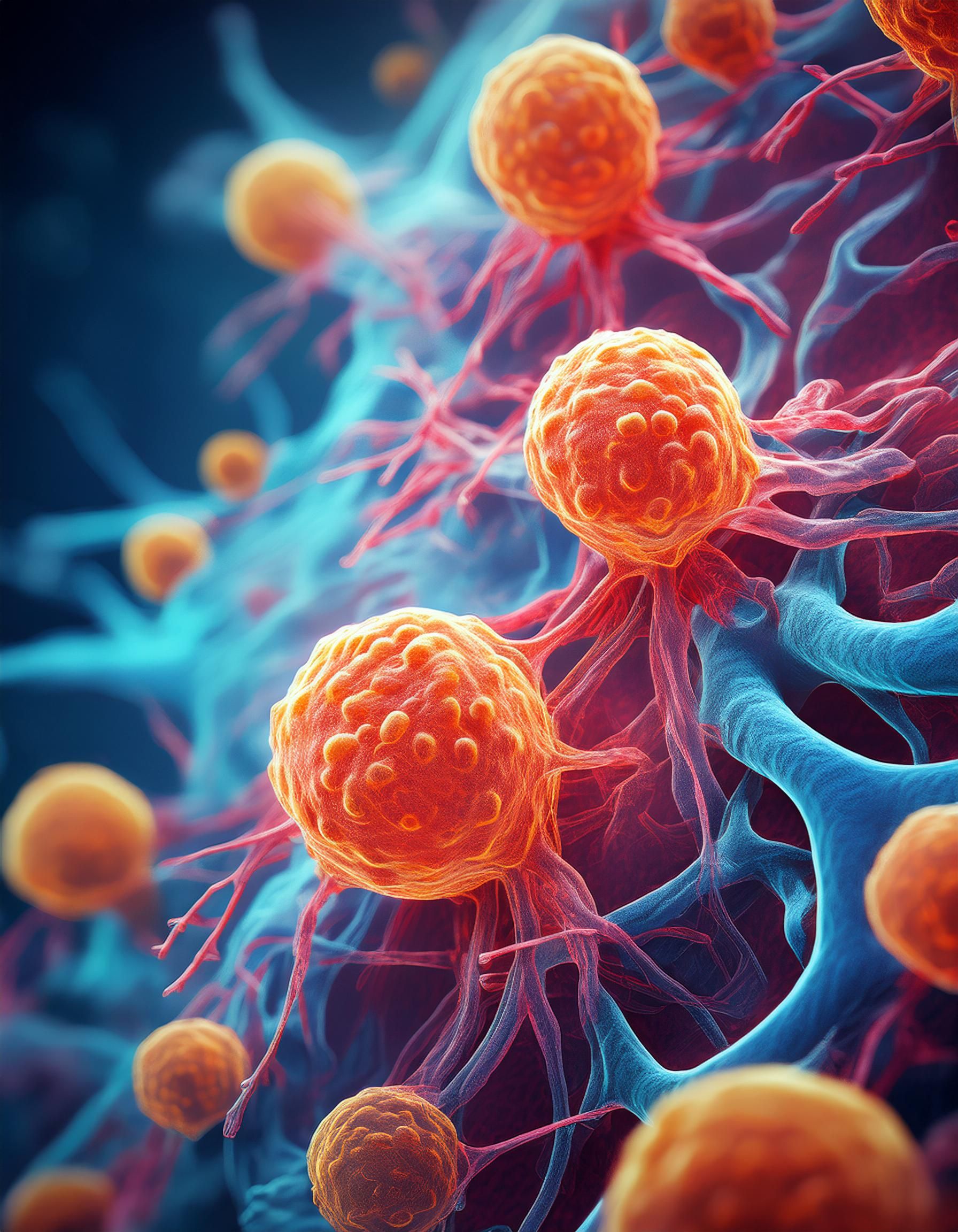Novel Radioenhancer JNJ-1900 Shows Potential Across Cancers
Jared Weiss, MD, discussed the mechanism of action of JNJ-1900 and the preliminary data presented at the 2025 European Lung Cancer Congress.
Jared Weiss, MD

JNJ-1900 (NBTXR3) shows potential as an innovative approach to enhance local tumor control without escalating systemic toxicity across solid tumors, including lung cancer, according to preliminary findings from an ongoing phase 1 study (NCT03589339) presented at the 2025 European Lung Cancer Congress (ELCC).1
This novel radioenhancer, composed of functionalized hafnium oxide nanoparticles, is designed to amplify the effectiveness of radiation therapy. Administered through a single intratumoral injection, JNJ-1900 is activated by radiation, increasing the absorbed dose within tumor cells while aiming to spare surrounding healthy tissue.1
Early results from this study have highlighted this innovative approach’s potential to enhance local tumor control without escalating systemic toxicity.
JNJ-1900 is also being evaluated in the global, phase 3 NANORAY-312 trial (NCT04892173) in head and neck cancer and lung cancer, a phase 2 trial in unresectable stage 3 non–small cell lung cancer (NSCLC), the phase 1 MDA 2019-1001 study in locally advanced or borderline resectable pancreatic cancer, and the phase 1 MDA 2020-0123 study in NSCLC amenable to re-irradiation.2
In an interview with Targeted OncologyTM, Jared Weiss, MD, professor of medicine and section chief of thoracic and head and neck oncology at UNC Lineberger Comprehensive Cancer Center, discussed the mechanism of action of JNJ-1900 and the significance of the preliminary data.
Targeted Oncology: Please explain the mechanism of action of JNJ-1900.
Weiss: The product is a hafnium nanoparticle. The gist of the procedure is you inject that nanoparticle into a spot of tumor that you plan to deliver radiation to, and then you deliver hypofractionated radiation to that spot. What results are 2 desirable, clinical things. One is you fry the tumor locally, and the other is that you seem to induce a systemic immune response. It is sort of like having your cake and eating it too. Mechanistically, the way it works is easier to explain on the local frying side—highly technical terms. When you deliver a photon to the hafnium nanoparticle, what happens is that for every photon it absorbs, it releases 9 electrons, and electrons don't go very far. So what you get is this amplification of a local destructive effect that seems to be doable in previously irradiated areas.
The systemic immune response to me, has a sting like flavor, but the full mechanism of that, I think, either with hypofractionated radiation alone, or with the hafnium nanoparticle combination. People have very different ideas about that and I do not think that has been properly proven, but there is strong evidence preclinically, and arguably more importantly, in previously presented clinical data, that that systemic response does seem to happen because there have been abscopal responses in untreated lesions, and that that word abscopal is kind of important. Usually it is a joke from [medical oncologists] to [radiation oncologists] when we do that, because the word abscopal is probably 10 times more common in presentations from radiation oncologists than seen in the real world. But there were real documented ones in the 1100 study.
Microscopic, photorealistic image of lung cancer cells - Generated with Adobe Firefly

Can you describe the background of this study? What were the trial's inclusion/exclusion criteria and their impact?
1100 was a larger study than what we just saw at ELCC. It included patients with head and neck cancer, with inoperable disease and tumor in previously irradiated fields, patients, there could be anti–PD-1 naive or nonresponders. There was a population with liver metastases where patients could have been both naive or nonresponders. But the ELCC presentation focused on a very interesting group, which is patients with lung metastases from any tumor. That's interesting because the lung can be a difficult site to access clinically, and so there were feasibility questions that the ELCC data addresses, and so is any solid tumor metastatic to the lung. The tumor to be irradiated, or treated and then irradiated, could not have been previously irradiated. The patient had to be eligible for PD-1, because this is a PD-1 combination, but patients could have been either PD-1 naive or a nonresponders.
What were the key safety findings and toxicities observed?
This was data specific to the lung population. It was divided up by central lesions and peripheral lesions, because when accessing the lung, we think of these differently. But whether you look at that data separately or in combination, grade 3 adverse events were quite rare. With events related to the injection procedure, there was 1 pneumothorax, there was 1 [palmitoylethanolamide]. With events related to radiotherapy, there was 1 grade 3 dyspnea. We were not seeing anything unexpected or novel. Critically, the feasibility also looked quite good for this anatomy.
Can you just describe the feasibility end points and any early efficacy signals?
The lung is often spoken about in terms of difficulty accessing tissue. We talk about molecular therapy, we talk about failure to get enough tissue, and so that feasibility was absolutely critical. Part of the feasibility is the toxicity data we have already discussed. The other is the success of injecting the intended volume of product, and that looked rather good. Pretty much patients got injected with what they were supposed to get injected.
How do you think this agent may fit into early-stage lung cancer treatment moving forward?
We showed high response rates, both in immune checkpoint inhibitor–naive and –resistant patients. The population addressed here was not early-stage lung cancer, but your question is an extremely rational one for a local therapy. We give local therapies overall for local diseases, and this concept of having your cake and eating it too. Treating a local lesion in a powerful way, but also having a systemic response, is really critical for the lung, where we have problems with both local and distant control.
There are no clinical data to address your question, but I think some of the other emerging data that surround this do certainly inform it. We have had data that the modality of radiation probably matters for immune potentiation with hypofractionated radiation looking better than standard fractionation that fits in nicely with this paradigm. We have also had data on neoadjuvant and perioperative chemoimmunotherapy that fits in nicely with this data. Finally, we have had recent data from a variety of tumors for potentiation of immunotherapy. It might be good to not hit the first draining nodes. That primary radiation alone might be a desirable thing to allow for that antigen presentation.
All of this suggests that the science and clinical data are lining up to address that question you asked that there's a lot of potential here in early-stage lung cancer. I do not work for either of the companies involved here, and I am not aware of any planned studies to address that, but I think that at upcoming scientific advisory boards and such, that's something we are definitely going to be talking about, because your question is a natural one. All the data is kind of converging on that being a good idea.
Are there any planned clinical development steps?
With regard to lung cancer, we await data on a phase 2 study of inoperable stage III disease and a phase 1 study of inoperable, recurrent disease. Other studies are ongoing or planned in other disease states. The most advanced of these is in my other cancer, head and neck cancer, and that's NANORAY-312 in the elderly, platinum-ineligible, locally advanced context. It is a real population we see with regularity, and that will hopefully complete in 2026.
How does this agent differ from other radiotherapy enhancement strategies?
As a clinician, I like the “have your cake and eat it too” aspect of this. I have a very active local modality that also helps induce a systemic response that is important in lung cancer. We often use local modalities for palliative purposes in the stage IV patient, but they never produce a survival advantage, or almost never. On the other hand, if we look at where the survival advantage has come in recent years, it has been mostly immunotherapy. The idea of something that can provide that local control, that is sometimes important for palliation, sometimes important for local control and curative context, but also induce that systemic response, makes this exciting for me, and that is why I wanted to be heavily involved in this.
Are there any practical logistics of the administration of JNJ-1900?
Not every site in the body is going to hold the product. You need a certain density, a low enough density, that you are going to get the product in, but not so low density that the product is just going to squirt out. [Also,] you need a clinical population that is going to be PD-1 addressable. In addition to the anatomic concerns, you'd want a place that is attractive for radiotherapy, ideally, because you want to do it anyway, but at the minimum, that it is at least safe and feasible.










